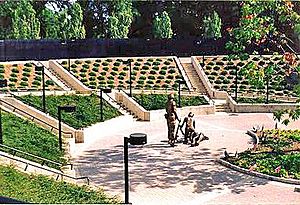New Jersey Vietnam Veterans' Memorial facts for kids
The New Jersey Vietnam Veterans' Memorial is a special place in Holmdel, New Jersey. It honors people from New Jersey who served in the Vietnam War. This includes 1,565 men and one woman who sadly lost their lives or went missing during the war. The memorial was opened in 1995. It is located next to the PNC Bank Arts Center and the Vietnam Era Museum and Educational Center.
How the Memorial Was Built
On January 21, 1986, New Jersey's Governor Thomas Kean signed a law. This law set aside $25,000 to help design a memorial for Vietnam veterans. It also created a special committee. This committee's job was to pick a location for the memorial. They also had to raise money and hold a design contest.
The committee chose the Holmdel site in 1986. They officially dedicated the land in 1987. From 1987 to 1988, a design competition took place. More than 400 different ideas were sent in. The winning design was chosen in 1988. It was created by Hien Nguyen, an architect from Vietnam. He had moved to the United States in 1975.
Governor Kean held a special ceremony to start construction on May 7, 1989. In May 1991, three statues for the memorial were shown in Trenton. These statues were made by Thomas Jay Warren. Building of the memorial officially began on November 19, 1991. The memorial was dedicated and opened to the public on May 7, 1995. This date was chosen because it was 20 years after the Vietnam War ended.
What the Memorial Looks Like
The memorial is an open, circular area. It is about 200 feet wide. Around the outside, there are 366 black granite panels. Each panel is 8 feet tall. Each panel represents a day of the year. The names of those who died are listed on the panel for the day they were lost.
In the center of the circle is a red oak tree. This is the state tree of New Jersey. The tree provides shade for three statues. One statue shows a soldier who is hurt. Another shows a nurse helping him. The third statue shows a soldier standing nearby. These statues represent different groups. They honor those who died, the women who served, and those who returned home safely. The statues also show different backgrounds. The hurt soldier is white, the standing soldier is African American, and the nurse is Latino.
The stone panels are about 12 feet higher than the inner courtyard. There are ten stairways and two ramps leading up to them. The designer made sure the ramps for people with disabilities were not separate. These ramps twist upwards like a double helix. Each ramp goes up halfway around the circle. The two entrances to the memorial are like tunnels. They symbolize the long journey soldiers took to Vietnam. The memorial is set up so that the May Seventh panel, which marks the end of the war, points towards Vietnam.
The Museum and Learning Center
The Vietnam Era Museum and Educational Center is right next to the memorial. An official from the center explained why it was built. The designer of the Vietnam Veterans Memorial in Washington, D.C. was asked what she would change if she could redesign her memorial. She said that without a learning center to explain the war, a memorial might not mean much to visitors. This idea led to the creation of this museum. In 2010, its name was changed to "Vietnam Era Museum & Educational Center."
The Vietnam Era Museum and Educational Center opened in September 1998. The building is 5,000 square feet. It cost $3.5 million to build. The goal was to provide a fair view of the war, which was a very debated topic. When it first opened, it was the only museum of its kind in the United States.


